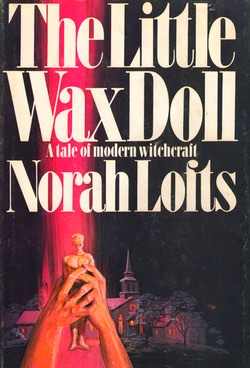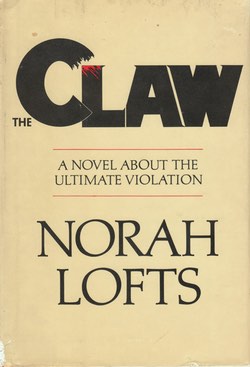In this series, Grady Hendrix, author of Horrorstör, and Will Errickson of Too Much Horror Fiction are back to uncover the best (and worst) horror paperbacks from the 1980s.
Historical romance novelist Norah Lofts wrote over fifty novels in her lifetime, working under her own name and the pseudonyms Juliet Astley and Peter Curtis. She wrote novels about Isabella of Spain, and Anne Boleyn, and Katherine of Aragon. She wrote a long series of interconnected novels about village life in the fictitious East Anglia town of Balidon. She wrote several novels that trace the lives and deaths of the inhabitants of some of England’s grand homes.
And, in 1982, she wrote The Claw about a living dead serial rapist who terrorizes an entire town, mutilating his victims with a massive iron claw.
That’s the problem with Norah Lofts: her books don’t do what they say on the box. Classified as a writer of historical romance, Lofts is more of a pure novelist than anyone else I’ve read in this series. The Little Wax Doll (aka The Witches, aka The Devil’s Own, aka Catch as Catch Can) is billed as revealing the strange and creepy practices of a rural witch cult in the modern English countryside. Those expecting Harvest Home are bound to be disappointed. Besides throwing the narrative for a wild loop in the middle (which essentially sees the witches win) the book ends with a moment of triumph for our hero before simple human vanity causes a supporting character to send her victory train screaming off the rails as the book comes to an abrupt close.
Loft’s historical romances are maybe even more concerned with the laws of inheritance than they are with the laws of romance. As one blogger speculates, “I wonder how many readers picked them up expecting to be transported to a delicious tale of swooning damsels, only to find they had been sucked into a gritty story of murder and medieval farming practices.”
But the thing about Lofts is that she’s so damn good. Historian Alison Weir says that Lofts “deserves to be accounted one of the great writers of the twentieth century,” and calls her Suffolk Trilogy (three books relating 600 years in the life of a medieval home) “the most outstanding historical novel that I have ever read.” Joan Fontaine, star of Alfred Hitchcock’s Rebecca and Suspicion, was such a fan that she personally brought Loft’s The Little Wax Doll to Hammer Studios as a vehicle for herself. Released as The Witches, it was her final film.
 What makes her so good is her commitment to character and her disdain for plotting, her attention to the single odd detail that suddenly brings a scene to life, and her light touch with understatement. But reading her today delivers an extra layer of pleasure because she’s a historical novelist in the best sense of the term. Lofts died in 1983 and even her contemporary books are about people who possess attitudes and beliefs that feel almost like science fiction in 2015. The Little Wax Doll, first published in 1960, is refreshingly forward-thinking when discussing African culture, but when it comes to the prospects for young people living in rural England it’s downright dystopian.
What makes her so good is her commitment to character and her disdain for plotting, her attention to the single odd detail that suddenly brings a scene to life, and her light touch with understatement. But reading her today delivers an extra layer of pleasure because she’s a historical novelist in the best sense of the term. Lofts died in 1983 and even her contemporary books are about people who possess attitudes and beliefs that feel almost like science fiction in 2015. The Little Wax Doll, first published in 1960, is refreshingly forward-thinking when discussing African culture, but when it comes to the prospects for young people living in rural England it’s downright dystopian.
That’s partially where The Claw derives so much of its power. Switching between different points of view, including third person omniscient, it can’t be said to have a main character unless that happens to be Greg Chambers, an accountant who cuts a swath of terror as he brutally rapes seven women. With chapters narrated by the victims, and Lofts dipping in and out of the minds of the police, local reporters, various alcoholics, the wife of the rapist, and a couple of schoolchildren (whose experiments with sulfuric acid is what ultimately brings the rapist down), it’s a crazy quilt that paints a portrait of an entire town, not just one crime.
Taking place 30 years ago, the attitudes towards rape feel both alien and familiar. Some of the women fight back. Some are passive. Some hide what happened to them. Others go immediately to the police. Some of them brush it off as if they’re relieved to have it over with so they can move on, others never recover. Some use the sympathy they earn to their own advantage. Others refuse sympathy entirely. At times it feels like visiting a distant planet, as when one police officer refers to rape as “only a minor crime.” After all, he reasons, it’s not like anyone died.
But what unsettles isn’t the rapes themselves. It’s the rapist. In the first chapter of the book, Greg dies in an accident. A few pages later, his mother-in-law resurrects him with a little off-the-cuff witchcraft. Nothing is ever made of this, in fact, it’s never even mentioned again. But it’s clear to the reader that Greg has come back like Stephen King’s revanants in Pet Sematary: some essential element of his humanity is missing. His presence is supernatural, uncanny. He smells like an animal, his victims can’t agree on his apperance (one thinks he looks like Pan, another says he’s a literal skeleton). He seems to appear and disappear from crime scenes at will.
Even more disturbing is the fact that Greg, a happily married father of two who is also a sexual sadist, isn’t the only person in this book living a double life. Character after character turns out to be either more or less than they seem. Teenaged daughters have rich lives their parents are oblivious to. Wives aren’t the devoted drudges their husbands imagined, and their husbands are secret gossip-mongers and snobs such that their wives would never suspect. Silly-looking women turn out to be sharp businesspeople, and broken-down prostitutes turn out to have once been minor celebrities.
Out of everyone I’ve read for this series, Lofts is the one I’m going to read more of. Her books are briskly written, and she doesn’t feel a need to attach a message. They simply are, and we get out of them what’s on the page. But more than that, she knows that every person is a mystery and there’s no way to really know them. The nice man who does our taxes may have a homemade claw in his cupboard, that silly school teacher wearing dowdy clothes might be the one person capable enough of taking down a witch cult. Lofts knows that when it comes to other people, none of us has a clue.
Grady Hendrix has written for publications ranging from Playboy to World Literature Today and his latest novel is Horrorstör, about a haunted Ikea.










